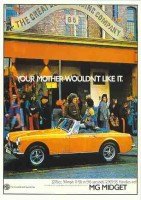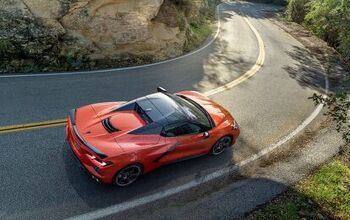Guaranteed Trouble
With the odds of at least one of The Big 2.8 filing for Chapter 11 rising, the analogists are crawling out of the woodwork. While the multiple and varied demises of the [now deceased] British Motor Industry make for interesting reading and some neat analogies, the truth is that such any such comparison is apples to oranges, or, more accurately, chalk and cheese. The first major point of divergence is the level of failure. Relatively speaking, the boys from Detroit haven't even BEGUN to fail.
Beginning with a forced merger in 1967, the various companies that made up the "native" British auto industry went through a government takeover/bailout, a sale to a "private" holder, and a forced sale to private investors. In between, there were a handful of profitable years (mostly in the mid 80s, thank you Honda-san) and two and a half brands "escaping." Land Rover and MINI came out through BMW, with the former being sold on to Ford, who had bought up Jaguar (that ended well).
By comparison, while they have had terrible years, and shed market share with few upticks, the worst The 2.8 have seen is Chrysler receiving federal loan guarantees (c. 1980). By that time, BLM had been nationalized. They were using their second bail-out package to right the ship. There are rumblings of break-ups and aid going Detroit's way, but nothing concrete as yet. And remember: whatever handouts Detroit secures will require Congressional approval (think the Alabama or California Reps will vote for them?).
Bad as the last five or six years have been, it should be remembered that these bad times came after an obscenely profitable decade for Detroit. The British industries downward spiral began at the end of their heyday through the swinging ‘60s. The problem was, that despite having two of the most revolutionary (and popular) cars in the world (the original Mini and the 1200 series) they made virtually no profit. Simply put, they under-priced their sales darlings.
This is ineptitude stunning beyond words. Auto writers have been blasting Motown for fusty short-sightedness for decades. But no one ever accused them of not knowing what their profit was. According to most accounts, the boys at Ford England figured out that BMC was losing ₤30 on every ₤500 Mini they sold. BMC was merged with a smaller truck-centric coalition of brands (Leyland) because they failed to make hay while the sun shined.
The other false analogy is one of scale. While the numbers varied, the British car market is/was roughly 10 to 12 percent of the size of the US market. Sales volumes that sound impressive on one side of the pond, sound like rounding errors on the other.
The eternal dilemma for any automaker is utilizing all their capacity. The eternal dilemma for BLC was that they would get money for new product and new lines and then fail to reach their sales targets, which meant no new development without more government money.
The 2.8 have some of the under-use issues on a plant-by-plant basis. But they have always made enough profit on their "hot" products to fund new products. They have traditionally strung out development and pinched pennies as a matter of choice. not necessity.
Thee other major difference: BLC's export reliance. Even when they held 30 percent of the British market (about 450k cars), BLC still needed to move over 200k cars to rationalize their capacity. This was/is common for much of Europe's fragmented market. It is almost entirely foreign to the 2.8 (who have subsidiaries for that).
Depending on exports for profits is a bad idea in several ways. An export-lead company is much more vulnerable to changes in the economy, from trade barriers to currency fluctuations. More importantly, exporting is conducive to irrational optimism combined with utter ignorance.
Smaller markets can be abandoned with little pain (until eventually you've left them all). Bigger export markets allow managers to float ridiculous sales numbers; 200k cars is a tiny part of the US market, without facing up to the actual difficulties of marketing. Lord knows the Japanese have had problems understanding the US market, and much of their staff rotates through a US posting.
The home-centered versus export-centered strategy for survival points toward yet another analogy, and gives The 2.8 hope that some of them can still prosper. The British car industry was preceded into extinction by the (even more export-dependent) British motorcycle industry. None of these once-famous names exists as a "real" company any longer. Harley Davidson, on the other hand, came back from the brink and is thriving by selling mostly in the U.S. market.
The Big 2.8 are in big trouble. But pay no attention to their bleatings about their foreign affairs. As BL's history proves, their salvation, if it comes, lies at home.
More by Andrew Dederer
Latest Car Reviews
Read moreLatest Product Reviews
Read moreRecent Comments
- Todd In Canada Mazda has a 3 year bumper to bumper & 5 year unlimited mileage drivetrain warranty. Mazdas are a DIY dream of high school auto mechanics 101 easy to work on reliable simplicity. IMO the Mazda is way better looking.
- Tane94 Blue Mini, love Minis because it's total custom ordering and the S has the BMW turbo engine.
- AZFelix What could possibly go wrong with putting your life in the robotic hands of precision crafted and expertly programmed machinery?
- Orange260z I'm facing the "tire aging out" issue as well - the Conti ECS on my 911 have 2017 date codes but have lots (likely >70%) tread remaining. The tires have spent quite little time in the sun, as the car has become a garage queen and has likely had ~10K kms put on in the last 5 years. I did notice that they were getting harder last year, as the car pushes more in corners and the back end breaks loose under heavy acceleration. I'll have to do a careful inspection for cracks when I get the car out for the summer in the coming weeks.
- VoGhost Interesting comments. Back in reality, AV is already here, and the experience to date has been that AV is far safer than most drivers. But I guess your "news" didn't tell you that, for some reason.


































Comments
Join the conversation
Though the story is set in a missile manufacturing plant, rather than an auto plant, a hilarious send-up of British industry during the "export or die" era is a Peter Sellers / Terry Thomas movie called "I'm Alright Jack" (my understanding is that this is British slang that translates roughly to "F-You, I Got Mine!" The stuff about labor unions (and their mentality) is priceless. I know that it's on DVD, and so is probably available on Netflix. Every UAW member should watch it - they see a bit of themselves and realize how self-destructive their union is to their future livelihoods (or lack thereof).
Serve the whine please! Let the whine flow..Who cared when the lights all went out in plants world wide?Some of the scribes encouraged this exodus.Lets see.. only Asians could build quality.The profit takers were seen as slave owners. Evil Fat cats who made a profit! Where are they today?Spending labors entitlement? Time to import Asian houses and politicians. Lets all read and embrace Asian ways... while we can...